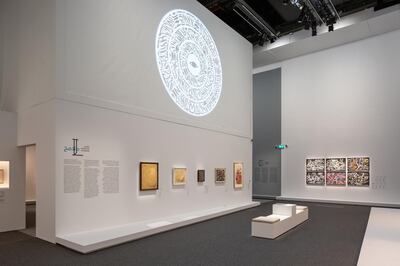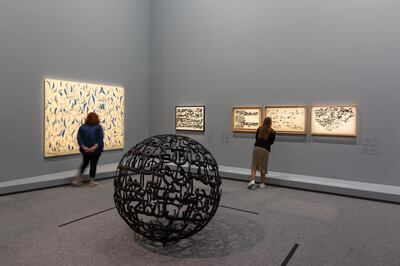One of the western art world’s most seismic shifts – the move from figurative to abstract styles – borrows a great deal of inspiration from the East.
Hieroglyphics, Kufic script and Zen calligraphy were among the writing systems that artists such as Paul Klee, Joan Miro and Andre Masson, and Wassily Kandinsky studied and dissected to bring new forms and shapes into their canvases.
Louvre Abu Dhabi’s latest exhibition, Abstraction and Calligraphy – Towards a Universal Language, examines how artists in the early 20th century sought to establish a visual vocabulary that would appeal to all, borrowing heavily from Asian and Islamic calligraphy as their source material.
The show opens to the public on Wednesday, February 17 and includes a total of 80 abstract artworks by pioneering artists from the western canon and the Arab world.
Split into four sections, the exhibition examines abstract art’s elements – from its use of symbols to its expressionist tendencies and links to calligraphy.
Such cultural connections have been acknowledged by the artists themselves, and the works they have produced are often more famed and memorable than their references.
This speaks to the prominence of western art history, but Louvre Abu Dhabi attempts to emphasise the role of visual art from the East by juxtaposing works with artefacts and contemporary paintings by Arab and Asian artists.
"The masterworks in Abstraction and Calligraphy, some on display in the region for the very first time, are exceptional for many reasons," says Mohamed Al Mubarak, chairman of the Department of Culture and Tourism - Abu Dhabi. "Not only because they have been crafted by some of the world’s most celebrated artists, but because they tell stories of discovery and inspiration across time, cultures and geographies.
Pictograms, the first section, includes a stone slab with Egyptian inscriptions from around 170 to 163 BC. It anchors works by Klee, Miro and Kandinsky, displayed alongside, which brim with pictorial characters and forms.
In Klee's Oriental Bliss, for example, the artist starts with a patchwork of luminous colours, adding a scatter of symbols reminiscent of pictograms in ancient writing systems. Klee was particularly fascinated by Egyptian hieroglyphs, in addition to Chinese and Arabic alphabets.
Unable to understand them, he focused instead on their shapes and geometric qualities.
The next section, Signs, moves from schematic to more fluid forms inspired by Chinese and Japanese calligraphy.
In the aftermath of the world wars emerged modernist and, by extension, post-modernist thought, with artists and writers experimenting with new forms of expression. In art, there was also an interest in the spiritual, in the way that Zen calligraphers linked their practices to explorations of consciousness.
These influences are seen in Masson's eye-catching scarlet painting Panic, covered with delicate strokes, and Georges Mathieu's The Princess Honora's Ring, which features a sweeping calligraphic form against a white background.
Lineaments, the show’s third section, presents abstract art at its most freed forms. In the 1940s, artists concentrated on movement and gesture, leading to bold strokes and drips as seen in action paintings, as well as layered experiments with colour. This style of abstract expressionism carries abstract art’s most well-known features and set about expressing the subconscious on the canvas.
Willem de Kooning's stunning work Untitled X, wherein blue and red waves flow and overlap like calligraphic writing, exemplifies this, as well as Jean Dubuffet's paintings of spontaneous, child-like scrawls.
Abstraction and Calligraphy - Towards a Universal Language ends with a focus on calligraphy.
Miro, in particular, saw the art form as the fusion of painting and poetry, and artists that followed after him, including Brion Gysin and Christian Dotremont, pushed this idea further through “painted poetry”, which is more about visual forms than language itself.
From a distance, the works of Jean Degottex and Mark Tobey appear as calligraphic scrolls, but a closer look reveals they only mimic these characters as a way to evoke the written word.
Artists such as Ghada Amer and Mona Hatoum go beyond the canvas or paper, giving words dimensionality with sculptural works.
Hatoum's Found (Wire Drawings) curl like letters of ancient text, though they are actually twisted pieces of metal collected from the ruins of Lebanon's civil war. Amer's sculpture The Words I Love Most consists of cast bronze that spells out Arabic words of love and humanity.
The exhibition also includes two new commissions by artists eL Seed, who lives and works in Dubai, and Sanki King, a Jeddah-born Pakistani artist who is now in Karachi.
The latter's Here I Am calligraffiti digital projection shows intricate rings that surround an eye, with passages inspired by a Muhammad Iqbal poem that express a "cosmic wholeness".
eL Seed’s eight-panel calligraphy of deep blues and oranges, meanwhile reads, “art is the shortest path from one man to another”, a hopeful summary of what Louvre Abu Dhabi’s latest show is all about.


![Installation view of Louvre Abu Dhabi's new exhibition Abstraction and Calligraphy - Towards a Universal Language shows Paul Klee's 'Oriental Bliss', right, on display next to Wassily Kandinsky's 'Trente [Thirty]'. Department of Culture and Tourism - Abu Dhabi; Seeing Things](https://thenational-the-national-prod.cdn.arcpublishing.com/resizer/v2/3TOWWIGJXEWUW5C56KWRITZIOI.jpg?smart=true&auth=bd92db87e3a7d761736d52422dbf44946db21834708c073f4556b85b5bae3c04&width=400&height=225)








![Paul Klee's 'Oriental Bliss', right, on display next to Wassily Kandinsky's 'Trente [Thirty]'. Department of Culture and Tourism - Abu Dhabi; Seeing Things](https://thenational-the-national-prod.cdn.arcpublishing.com/resizer/v2/3TOWWIGJXEWUW5C56KWRITZIOI.jpg?smart=true&auth=bd92db87e3a7d761736d52422dbf44946db21834708c073f4556b85b5bae3c04&width=400&height=266)

